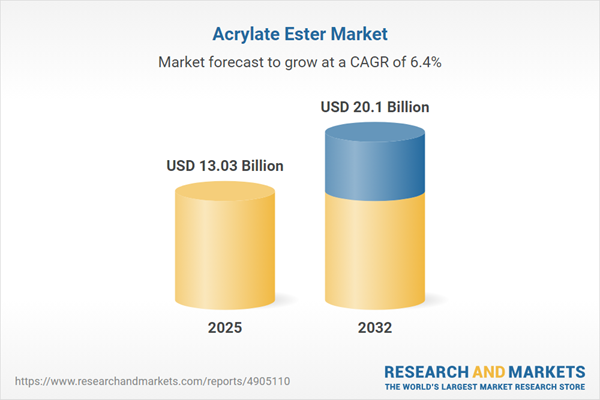Speak directly to the analyst to clarify any post sales queries you may have.
The acrylate ester market is experiencing dynamic change as organizations revise strategic priorities to address sustainability mandates, regulatory fluctuations, and shifting end-use demand. Senior decision-makers are challenged to maintain agility and competitive advantage in this fast-evolving landscape.
Market Snapshot: Acrylate Ester Market Growth Trends
The global acrylate ester market is currently valued at USD 12.25 billion, with projections indicating growth to USD 13.03 billion by 2025 and reaching USD 20.10 billion by 2032. Key sectors such as construction, automotive, electronics, and textiles are driving sustained demand, leveraging acrylate esters for their durability and adaptability. Ongoing innovation in material science and advances in processing technologies empower manufacturers to uphold stringent production standards, adapt processes, and respond quickly to evolving global and regional regulations. As procurement preferences and compliance benchmarks continue to shift, organizations require robust strategies that integrate technical excellence with operational flexibility.
Scope & Segmentation
- Application: Acrylate esters are vital for adhesives, sealants, coatings, plastics, textiles, fibers, pressure-sensitive products, and medical devices. Each segment benefits from enhanced material performance and improved process efficiency tailored to its requirements.
- Product Type: The market includes 2-Ethylhexyl Acrylate, Butyl Acrylate, Ethyl Acrylate, and Methyl Acrylate, offering manufacturers diverse options for managing end-use needs and input flexibility.
- Polymer Type: Coverage spans acrylic copolymers, styrene acrylic copolymers, and homopolymers, allowing seamless adaptation to compliance obligations and fostering product longevity in challenging conditions.
- Technology: Bulk, emulsion, solution, and suspension polymerization technologies support variable production scales and efficiency requirements, enabling adaptable solutions for different operational environments.
- Source: Both bio-based and petrochemical feedstocks are utilized, providing procurement flexibility to support sustainability goals and consistent supply chains.
- Form: Acrylate esters are available in liquid, pellet, and powder formats, enabling manufacturers to streamline processes, simplify logistics, and meet customer-specific delivery expectations.
- Sales Channel: Distribution is coordinated through direct sales, intermediaries, digital platforms, and retail networks, expanding reach and serving evolving procurement patterns across geographical regions.
- Geography: The market spans the Americas, Europe, the Middle East and Africa, and Asia-Pacific, each region influenced by local regulations, supply chain frameworks, and client requirements.
- Companies Profiled: Major participants include Dow Inc., Arkema S.A., BASF SE, Evonik Industries AG, Mitsubishi Chemical Holdings Corporation, Sumitomo Chemical Co., Ltd., LG Chem Ltd., Kaneka Corporation, Allnex Group S.à r.l., and Shandong Yousuo Chemical Co., Ltd.; these illustrate the range from established global players to emerging specialists.
Key Takeaways for Senior Decision-Makers
- Customized acrylate ester solutions enable agile adaptation to fast-changing market and customer needs across multiple industries.
- Continual technological improvement in polymerization methods supports compliance with evolving standards while optimizing quality outcomes.
- There is an ongoing market transition toward waterborne and UV-cured resins to address stringent environmental guidelines and align with corporate sustainability strategies.
- Accelerated adoption of bio-based feedstocks is enhancing sustainability credentials, meeting expectations of environmentally focused partners and end users.
- Supply chain strategies that prioritize resilience and operational diversification can reduce exposure to volatility and help organizations meet global production demands.
- Collaboration across the value chain is fostering efficient innovation and stronger responsiveness to market changes and regulatory updates.
Acrylate Ester Market Tariff Impact
With possible U.S. tariffs on the horizon in 2025, companies are proactively reviewing global sourcing options and diversifying production footprints. Emphasizing local manufacturing and flexible logistics is emerging as a central approach to counteract potential trade barriers, safeguard access, and sustain operational resilience.
Methodology & Data Sources
This analysis draws on executive interviews, industry journal assessments, patent reviews, and sector association input. Independent expert modeling validates the reliability of these findings, providing guidance aligned with the priorities of senior business leaders.
Why This Report Matters
- Supports strategic reviews of technology and business models to ensure alignment with key market trends specific to acrylate esters.
- Enables leadership to respond effectively to regulatory and compliance shifts, promoting informed resource allocation and risk mitigation.
- Identifies actionable growth opportunities and helps refine market positioning based on innovation and sustainability drivers.
Conclusion
This report offers practical, actionable insights for executive teams seeking to strengthen risk management, inform strategic decision-making, and identify growth opportunities within the acrylate ester market.
Additional Product Information:
- Purchase of this report includes 1 year online access with quarterly updates.
- This report can be updated on request. Please contact our Customer Experience team using the Ask a Question widget on our website.
Table of Contents
3. Executive Summary
4. Market Overview
7. Cumulative Impact of Artificial Intelligence 2025
Companies Mentioned
The companies profiled in this Acrylate Ester market report include:- Dow Inc.
- Arkema S.A.
- BASF SE
- Evonik Industries AG
- Mitsubishi Chemical Holdings Corporation
- Sumitomo Chemical Co., Ltd.
- LG Chem Ltd.
- Kaneka Corporation
- Allnex Group S.à r.l.
- Shandong Yousuo Chemical Co., Ltd.
Table Information
| Report Attribute | Details |
|---|---|
| No. of Pages | 182 |
| Published | November 2025 |
| Forecast Period | 2025 - 2032 |
| Estimated Market Value ( USD | $ 13.03 Billion |
| Forecasted Market Value ( USD | $ 20.1 Billion |
| Compound Annual Growth Rate | 6.3% |
| Regions Covered | Global |
| No. of Companies Mentioned | 11 |









